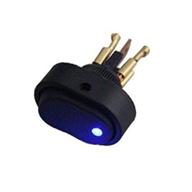
Review on SainSmart 101 70 100 2 Channel Relay Module by Anthony Rael

Works with 3.3V signals; provides 5V coil power
This compact relay board interfaces easily with 3.3V microcontrollers such as those found on wireless routers and Netduinos with little setup. The relay coils require 5V to switch, in my testing the 3.3V on the relay coils was not enough to switch the relay (but activated the LED). If your project uses a 3.3V microcontroller, you can still get excellent results with this relay. The left set of 3 pins comes with a jumper between JD-VCC and VCC, causing the relay coils to operate from VCC applied to the pin header on the switch side. To use a relay board with a 3.3V microcontroller, remove and save/discard this jumper, connect GND to power supply ground, apply 5V to the one marked JD for the relay coils pin labeled -VCC and 3.3V to one of the pins labeled JD-VCC to VCC. Your 3.3V microcontroller connects to IN1 and IN2, and due to the transistors on the board, the relay will only switch 3.3V at low current (about 20mA). Relay. This works fine; Microcircuits can usually draw more current than they can source. I was able to control this relay board from the GPIO pins of a TP-LINK MR3020 router without burning the SoC by powering the 5V coil from the USB input. All in all, this relay board is a great, inexpensive solution for internet control of just about anything.
- New
- Not the best
New products
Comments (0)
Top products in 🔋 Switches & Relays

Gaming headset ASUS TUF Gaming H3 (90YH02AR-B1UA00) black-red

46 Review

Illuminate Your Ride With HOTSYSTEM'S Blue LED Toggle Switch - Perfect For Car, Motorcycle, Boat, And More!

37 Review

Portable bluetooth speaker BT Speaker ZQS-8210 high power universal

35 Review

BMW Engine Ignition Start Stop Button Replacement - Compatible With 1 3 5 6 X1 X3 X5 X6 Series (E81 E90 E91 E60 E63 E84 E83 E70 E71) By Jaronx Sports Red

49 Review





